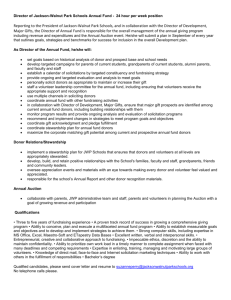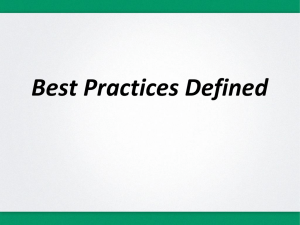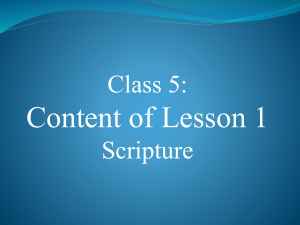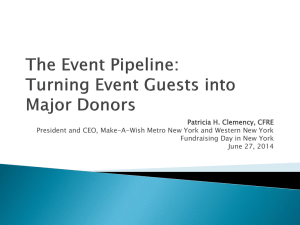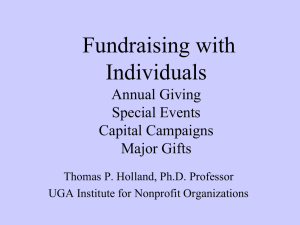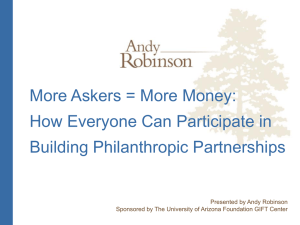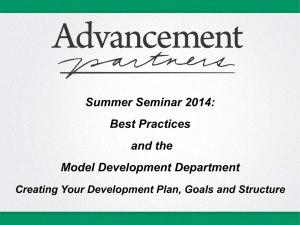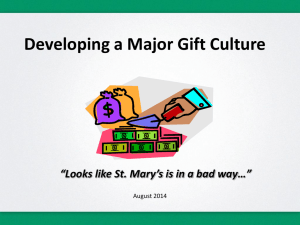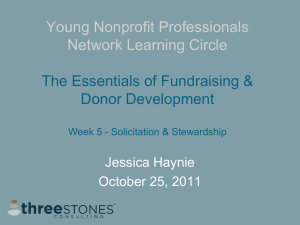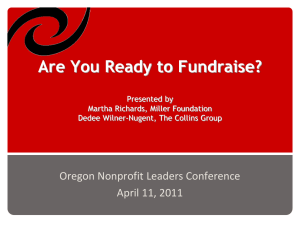Spaghetti Again? - Habitat for Humanity
advertisement
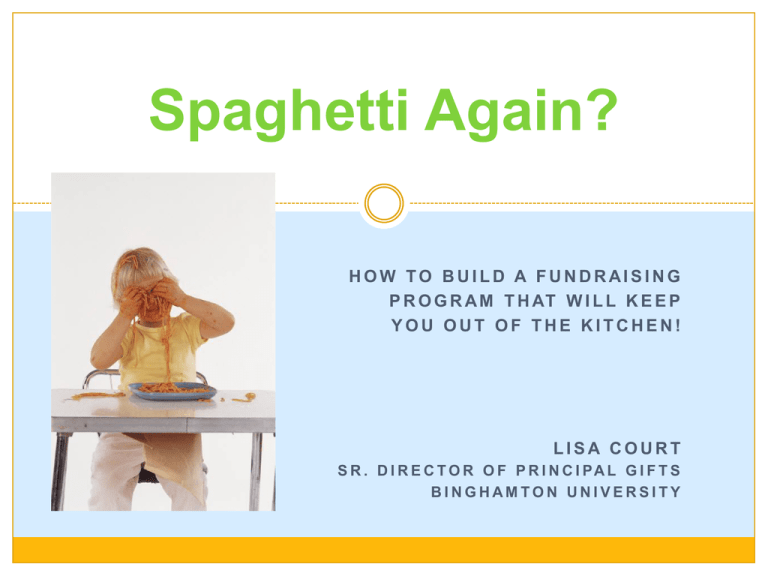
Spaghetti Again? HOW TO BUILD A FUNDRAISING P R O G R A M T H AT W I L L K E E P YOU OUT OF THE KITCHEN! LISA COURT S R . D I R E C T O R O F P R I N C I PA L G I F T S BINGHAMTON UNIVERSITY Special Events Have Their Place Profile and PR Expand the audience Broadcast the mission Engage and Mobilize Volunteers Friend-raise - build a committed constituency (not just a mailing list) Steward and acknowledge your donors Celebrate success At your last Special Event… Did you get a good return on your investment? Does your event provide a good return on your investment of your time, energy and finances? Is it part of a balanced fundraising strategy? What’s the impact on volunteers? Special Events Are one tool in your tool belt. Use them sparingly. Combine them with a balance of in person solicitations, direct mail and phone calls. Your highest ROI will result from a face to face ask. ALMOST ALWAYS. A Balanced Fund Raising Plan Annual Fund Mail Appeals, Phonathons, Leadership Giving Major Gifts Estate Gifts Gifts in Kind Endowments Capital Campaigns Special Events Case for Support Typically communicates mission and values importance and urgency specific objectives history and credibility illustrates how the donor can help Who are your donors? Who is your audience? Are they informed? Are they ready? What is your history with them? Fundraising Success and the Economy You can be successful in fundraising in any economic climate… Your case must be compelling It must warrant support It must well articulated and capable of being thoroughly understood by all a nonprofit’s donors YWCA of Cortland - More than you can imagine! Raised $101.2 Million BOLD BRILLIANT BINGHAMTON Original Goal $95 Million Considered suspending the campaign because of the economic downturn Successful during a time of great institutional transition. “It was a risk, but it the right risk.” It was a good investment and everyone was ask to invest. Why did these campaigns succeed? Leadership and organization Committed Executive and board support Volunteers Research and readiness through feasibility study Strong programs Informed and engaged community that valued their service Professional counsel And they asked, and asked and asked for the big gifts An inconvenient truth… To get people to give you money, you usually have to ask for it. Before you ask anyone for their gift… Make your own “stretch gift.” Your own sacrificial gift create momentum and energizes you to ask others for their support. The most successful fund raising efforts are achieved when you’ve already made your own commitment. Your Case for Support Begin with your mission statement "A Hand Up, Not a Hand Out.“ We seek to eliminate poverty housing and homelessness from the world and to make decent shelter a matter of conscience and action. Express the need in human terms Convey a sense of importance and urgency Be bold and inspirational Create opportunities for collaboration Your Blueprint - The Gift Cycle QUALIFY IDENTIFY CULTIVATE STEWARD SOLICIT Identification Prospects are: Donors, friends, community members, businesses, and foundations who have the capacity to make a major gift (as defined by your institution) and the inclination to do so. They are interested in your mission and institution and are philanthropic in nature. Where can I find prospects? Proactive research – prospects who come to your attention as a result of giving activity. Networking– names that surface in conversation, referrals from current donors or volunteers and those who attend your events Observation – individuals who you become aware of because of media coverage, their careers or lifestyle successes Previous giving, regular and increasing annual gifts or a particularly large jump in giving “You should go see…” A prospect has been identified but your challenge is how to approach them. Who is in their sphere of influence? Who are their business partners, church members, friends, club members etc… who can share information or advocate for your organization? Prepare to Qualify: Make Setting Appointments Your Priority Get excited about the visit. Block out your appointment or travel time each month. Set aside time during the week, usually several hours to devote your attention to setting up appointments. If you are not having success - stop, walk away and come back another day. Allow me to introduce myself… Prepare a letter or e-letter of introduction stating the purpose of your visit. Or, have a brief script prepared to explain the purpose of your visit over the phone. If you are new to the position attach at short biography and photo. If this is the first visit with a prospect, explain your visit in broad terms, “I am meeting with donors and past donors to identify individuals who are interested in helping us promote our program through…. A Word About Gatekeepers These are the people your prospects trust. Take note of who answers the phone, call them by name the next time you call. Respect their position and treat them with the same importance and cheerfulness as your prospect. Remember The process begins when you identify the individual The plan evolves over time As you engage and involve, there should be donor centered reasoning in the process A varied team is important Take time to reflect, think and check your strategy throughout the process Its about the donor – tailor your plans accordingly The objective is to bring the goals of your organization and prospect into alignment Qualification Meeting Establish Inclination and Capacity Ask Strategic Questions Exercise Athletic Listening Analyze – What did I hear – what does it mean? Build a Strategy What Do I Qualify? Capacity – know the types of assets that indicate wealth – it is unlikely that a donor will sell their house to make a gift Interest and Inclination – are they involved/ connected? Passion – sources of pride that can be reinforced, revitalized or revisited Timeframe – is there a compelling reason to move quickly/slowly – when is a gift likely? Asking Strategic Questions Tell me more How do you like to be involved with organizations you support? What organizations do you make your philanthropic priorities? What do you like to accomplish with your philanthropy? Do you like to entertain in your home? How’s business? How does the economy effect your philanthropic decisions? How did you get interested in HFH? Have you ever given to a capital campaign? About your relationship with HFH? How do you make your gifts? Have you ever made a planned or estate gift? Is HFH in your will? If I had a million dollars… How would you spend it? What charities would you give it to? How would you like HFH to use it? When you meet, what are you trying to achieve? Remind them about their experience with HFH. Renew their emotional connection. Update them on HFH activities. Determine where their passions connect with your vision. Identify ongoing organizational contacts. Gather info to update their personal profile. Be prepared for questions about all aspects of the organization. Cultivation: Building Rapport and Trust Its about the prospect, not about you. Watch, listen and read Stay alert Entertain their interests Involve in the organization Engage meaningfully Make introductions to leadership Ask their advice and follow up on that advice Special events as effective cultivation Go small - some of the most productive means of cultivation are in small groups over a meal. Invite a speaker or the leadership to share their vision. Be judicious with special events – make them meaningful and a way to collect names and information Don’t let special events consume your fundraising time. Face to face gift solicitation is one of the most effective tools in your fundraising arsenal. Solicitation Soft ask or full on solicitation? Who is going on the call? Who will make the ask? Anticipate likely outcomes Review, research, coordinate and rehearse Prepare a script Solicitation Acknowledge the reason for the visit Ask for what you want I would like to talk to you about the HFH’s needs for… I’m here to ask for your help Be simple and direct… and then stop talking! The Soft Ask Permission to solicit – it’s a reality check – and a little tricky. Solicitation as cultivation – teaches donors about types of giving, develops solicitation rapport and helps to reinforce the importance of your organization and the ask on the table. Athletic Listening Give the donor time to talk Don’t think too loudly Go with the conversation – don’t force your script Is the donor raising issues you can address? If the conversation gets off track..Gently guide the conversation back to the topic at hand Ask for questions and feedback And stay on your toes and adapt your strategy as you go. Also listen to your co-solicitor and watch body language Can I take your pledge today? Ask for the Gift Could I send you a formal proposal May I call on you next week to see what you are thinking? What if the prospect says “No or I’ll think about it?” This is the most important time to listen actively to their rationale Restate concerns expressed What are their objections – Question and probe. Affirm and interpret Is the answer really no, not now, not that amount or not for this project? What if they say Yes? Thank the donor Confirm the details Leave Follow-up immediately Widen the circle of appreciation Stewardship Thank with a phone call from senior leadership Receipt appropriately Send acknowledgements from the appropriate source preferably the most senior officer or volunteer in the organization. Media coverage and print where appropriate Now, that you can ask for a gift in person Direct mail is a mechanism to reach out and fortify your base of support Decide how often you will mail – 1-2-3 times a year? Will your response rate dictate your budget? Can you launch a phonathon? Depending on the size of your list could you divide it up amongst your board? What can you realistically manage with the size of your board or volunteers? Most donors want verbal or written A word about plaques and thank you gifts acknowledgements and little more. Continued contact with organizational leadership and volunteers is always welcome. Showing regular written and verbal appreciation after the gift is better than a tchotchke or swag. They want as much of their gifts to support your mission. Think carefully about donor recognition trees and the like. Most of all, know what your donor wants and ask them. What’s My Strategy? From your prospect research you learn that Mr. and Mrs. Corey have been the construction business for three generations. They have been interested in HFH from the sidelines but have made small consistent annual gifts. Your references say they have significant wealth and have no children. They gave a gift of $100,000 to the United Way. They have two homes and are recently retired. Discuss a strategy on how to move them from the Annual Fund to a Major Gift. FINAL WORDS AND QUESTIONS There are no magic words to help secure a gift, the real magic is the relationship with those who can change the world with their generous spirit
